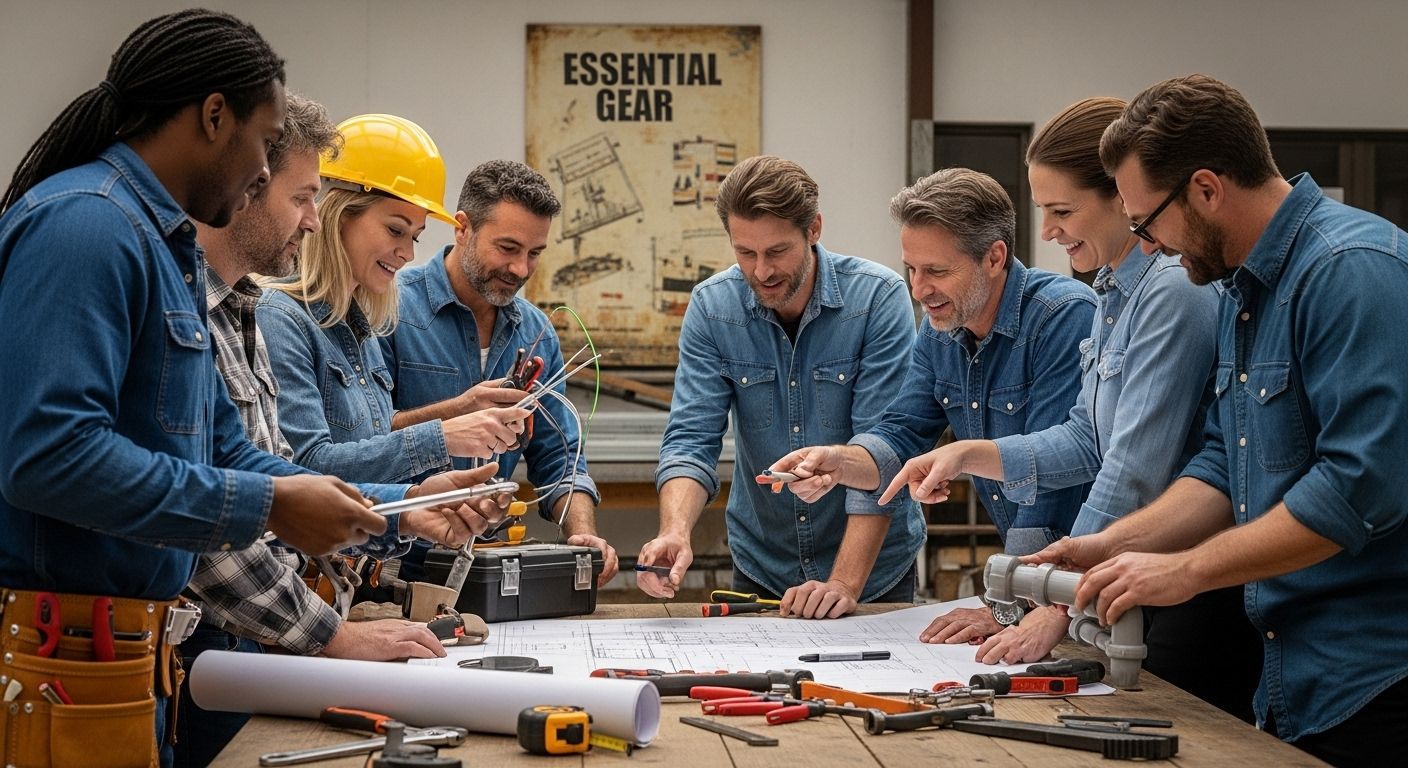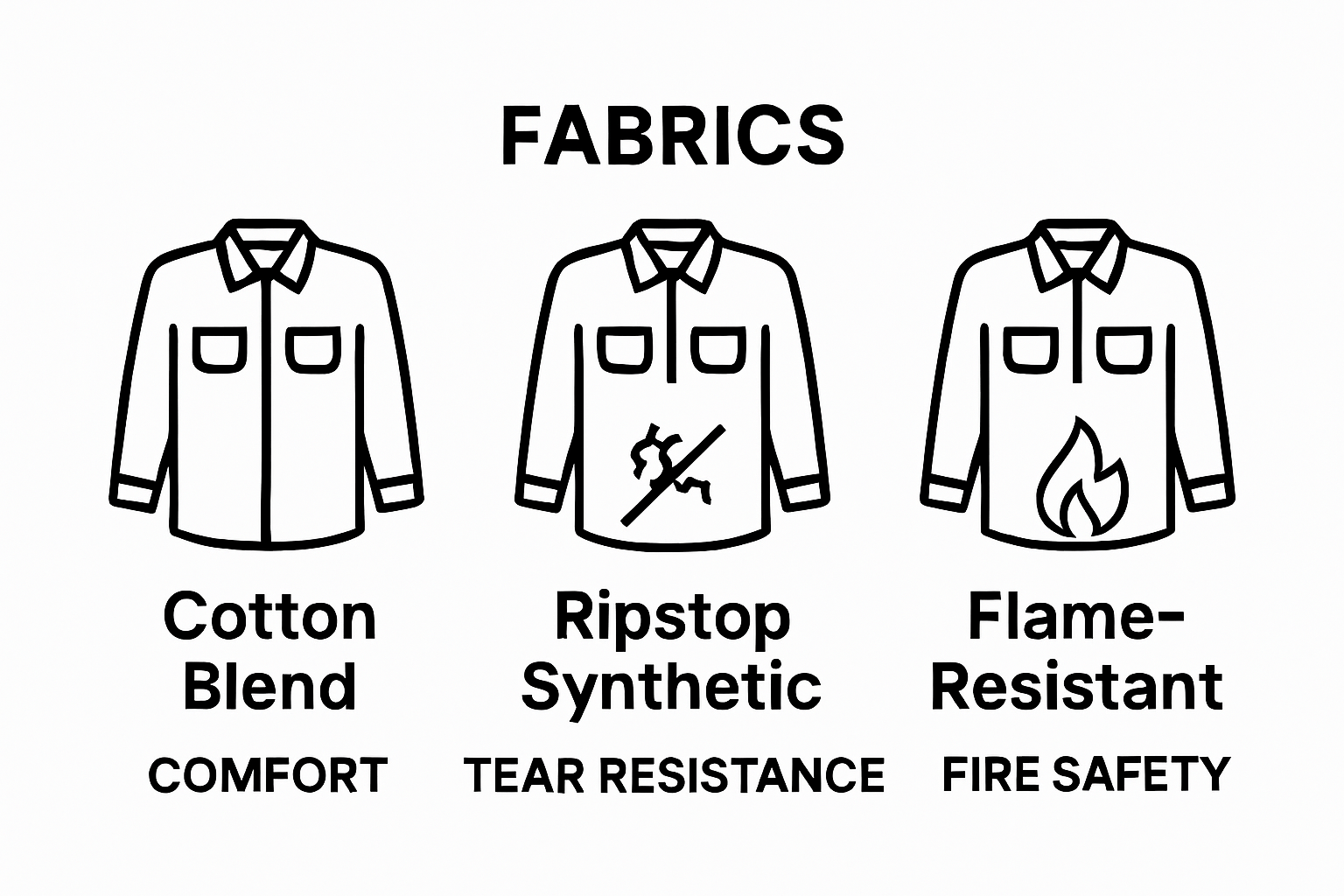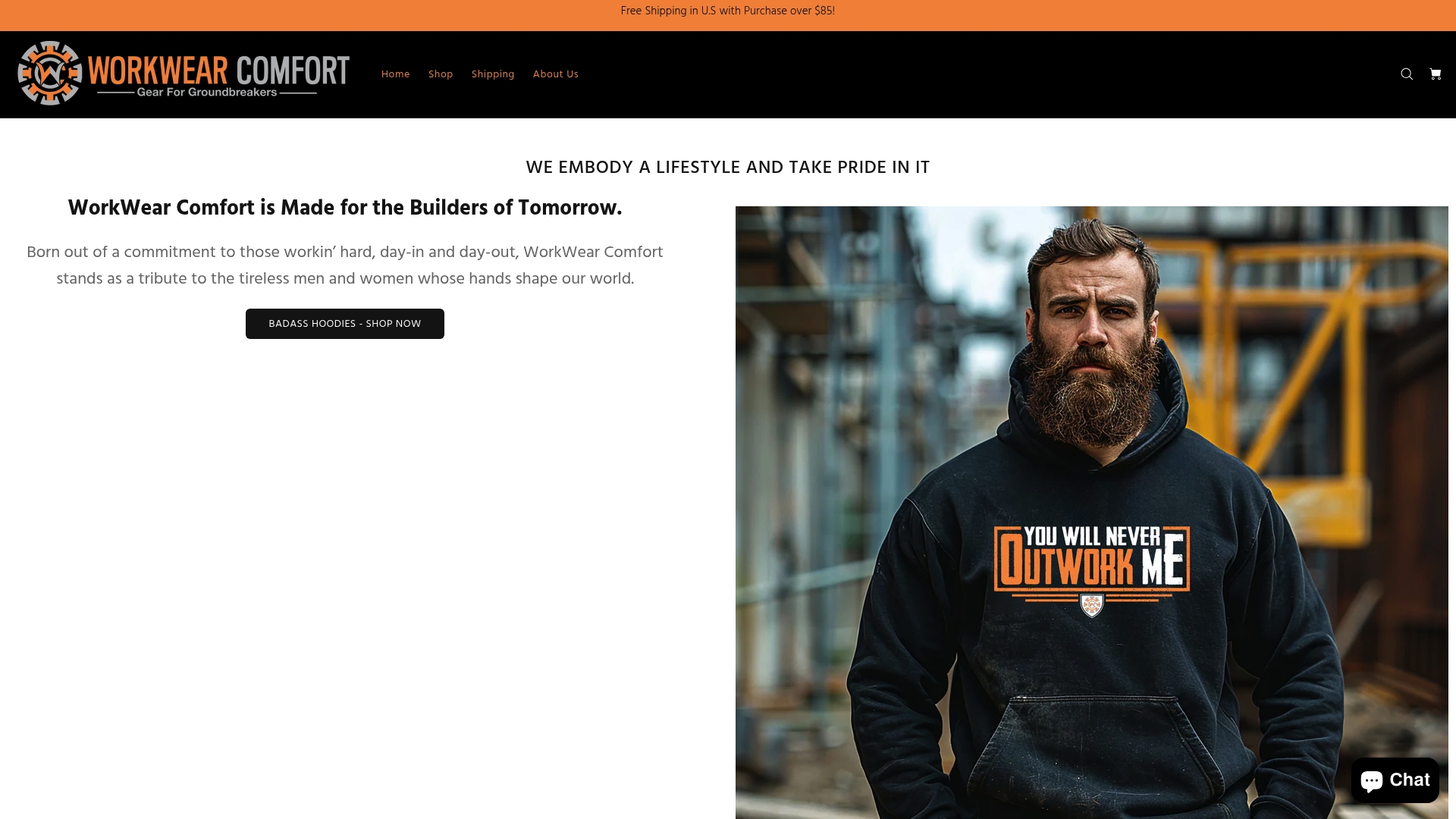
Blue collar work shirts might look like simple uniforms, but these garments are the backbone of safety and comfort for millions on job sites every day. While most people assume any shirt can handle tough work, studies show that durable fabric quality can cut replacement costs and lower injury risk for workers. The real surprise is that these shirts are more than just protective gear—they also carry the pride, skill, and identity of the entire trades community.
To clarify the differences between standard shirts and blue collar work shirts, here is a comparison of their design, durability, and functional benefits.
| Feature/Aspect | Standard Shirt | Blue Collar Work Shirt |
|---|---|---|
| Durability | Moderate, often lower | High, designed for repeated heavy use |
| Material Type | Basic cotton or blends | Reinforced cotton, ripstop, synthetics |
| Safety Features | Rarely included | UV/flame resistance, reinforced points |
| Comfort & Mobility | Standard fit | Enhanced mobility and thermal control |
| Professional Symbolism | Minimal | Reflects trade expertise, pride |
| Replacement Frequency | Frequent | Lower (longer lifespan) |
| Cost over Time | Can be higher due to replacing | Lower, due to durability |
Table of Contents
- What Are Blue Collar Work Shirts And Their Purpose?
- Why Durable Fabric Matters In Blue Collar Work Shirts
- Key Features Of Effective Work Shirts For Tradespeople
- Understanding Comfort And Mobility In Work Apparel
- The Role Of Blue Collar Work Shirts In Professional Identity
Quick Summary
| Takeaway | Explanation |
|---|---|
| Blue collar work shirts provide essential protection. | These shirts are designed to safeguard workers from injuries, extreme temperatures, and environmental hazards. |
| Durable fabrics are crucial for safety. | High-quality materials extend the lifespan of work shirts and maintain protective features, reducing workplace risks. |
| Comfort enhances worker performance. | Proper design ensures mobility and temperature regulation, which boosts productivity and minimizes fatigue. |
| Work shirts symbolize professional identity. | They reflect a worker’s trade expertise, community belonging, and personal pride in their craftsmanship. |
| Investing in quality work apparel pays off. | Durable and well-designed shirts lower replacement costs and improve overall workplace safety. |
What Are Blue Collar Work Shirts and Their Purpose?
Blue collar work shirts are specialized garments designed specifically for professionals in trades, construction, and manual labor industries. These shirts go far beyond standard clothing, serving as critical protective equipment that combines functionality, durability, and workplace safety. Our comprehensive workwear guide explores the essential role these garments play in professional environments.
Functional Design for Demanding Environments
Unlike typical casual wear, blue collar work shirts are engineered to withstand harsh working conditions. They typically feature reinforced materials, strategic stitching, and specialized fabrics that provide protection against environmental hazards. The primary purposes of these shirts include:
- Protecting workers from physical injuries
- Providing thermal regulation in extreme temperatures
- Offering resistance to chemicals, dirt, and abrasive materials
- Creating high visibility in potentially dangerous work zones
Safety and Performance Characteristics
According to NIOSH workplace safety guidelines, work shirts play a crucial role in employee protection. Optimal work shirts integrate multiple safety features, such as:
- UV protection for outdoor workers
- Flame-resistant materials for high-risk environments
- Breathable fabrics that manage moisture and prevent overheating
- Reinforced areas like shoulders and elbows to increase durability
Tradespeople rely on these shirts not just as clothing, but as essential tools that support their daily performance and safety. The right work shirt can mean the difference between comfort and constant distraction, between protection and potential workplace risk.
This table details key safety and performance features commonly found in effective blue collar work shirts to help readers understand their protective benefits.
| Feature | Description |
|---|---|
| UV Protection | Shields workers from harmful sun exposure, reducing risk of skin damage |
| Flame-Resistant Materials | Protects against fire hazards in high-risk environments |
| Moisture-Wicking Fabric | Transfers sweat away from the body, keeping workers dry and comfortable |
| Reinforced Stress Points | Adds extra strength at elbows, shoulders, and high-wear areas |
| High Visibility Elements | Ensures workers remain visible in dangerous or low-light work zones |
| Breathable Construction | Promotes airflow to prevent overheating during physical activity |
| Chemical Resistance | Guards against exposure to hazardous substances in industrial settings |
Why Durable Fabric Matters in Blue Collar Work Shirts
In the demanding world of trades and manual labor, the durability of work shirt fabrics isn’t just a preference—it’s a critical safety requirement. Our comprehensive workwear guide highlights the fundamental role that high-quality materials play in protecting workers across various industries.
Material Performance Under Extreme Conditions
Durable fabrics serve as the first line of defense for blue collar workers, protecting against multiple workplace hazards. Fabric durability determines a work shirt’s ability to withstand constant stress, including repeated physical movements, exposure to harsh chemicals, abrasive surfaces, and extreme environmental conditions. The right fabric can mean the difference between a shirt that protects and one that fails when workers need it most.
According to OSHA’s Technical Manual, proper protective clothing evaluation requires assessing materials for:
- Resistance to tears and punctures
- Ability to withstand repeated use and contamination
- Structural integrity of seams and stitching
- Performance under repeated stress and washing
Economic and Safety Implications of Fabric Quality
Investing in high-durability work shirts offers significant long-term benefits for both workers and employers. Durable fabrics provide continuous protection while reducing replacement costs. Shirts constructed with advanced materials like ripstop fabrics, reinforced cotton blends, and specialized synthetic weaves can:

- Extend the operational life of work clothing
- Maintain protective properties after multiple wash cycles
- Reduce workplace injury risks from clothing failure
- Provide better value compared to frequent replacements
Ultimately, the right fabric is more than just a clothing choice—it’s a critical component of workplace safety and professional performance.
Key Features of Effective Work Shirts for Tradespeople
Blue collar work shirts represent more than standard clothing—they are sophisticated protective equipment engineered for challenging professional environments. Our comprehensive trades gear guide explores the nuanced requirements that transform a basic shirt into an essential safety tool.
Essential Performance Characteristics
Professional work shirts must deliver comprehensive protection and functionality. Beyond basic coverage, these garments are strategically designed to address multiple workplace challenges. According to OSHA safety guidelines, effective work shirts should incorporate several critical features:
- High visibility elements for worker safety
- Flame-resistant materials in high-risk environments
- Moisture-wicking capabilities
- Reinforced stress points to prevent tearing
- Breathable fabrics that support temperature regulation
Material Science and Workplace Protection
The sophistication of modern work shirts lies in their advanced material engineering. Cutting-edge fabric technologies transform traditional clothing into adaptable protective gear. Specialized work shirts now integrate performance characteristics like:
- UV protection for outdoor workers
- Chemical resistance for industrial environments
- Antimicrobial treatments to manage workplace hygiene
- Lightweight construction that doesn’t compromise durability
- Stretch fabrics that allow unrestricted movement
Tradespeople require clothing that works as hard as they do—adapting to changing environmental conditions while providing consistent protection. The right work shirt becomes an invisible partner in workplace safety, supporting performance and minimizing potential risks through intelligent design and material selection.

Understanding Comfort and Mobility in Work Apparel
Comfort and mobility are not luxury features in work apparel—they are critical performance requirements that directly impact worker productivity and safety. Our hot weather workwear guide explores how clothing design influences professional performance across challenging environments.
Biomechanical Design Principles
Work shirts must support the human body’s natural movement patterns. According to research published in Applied Ergonomics, clothing that restricts mobility can significantly reduce worker performance and increase fatigue. Professional work apparel must address several key biomechanical considerations:
- Allowing full range of shoulder and arm motion
- Preventing fabric bunching during repetitive movements
- Supporting natural muscle engagement
- Minimizing friction and chafing
- Accommodating dynamic posture changes
Thermal Regulation and Performance
Effective work shirts function as advanced thermal management systems. The human body generates substantial heat during physical labor, and clothing plays a crucial role in maintaining optimal performance. Specialized work apparel addresses thermal challenges through:
- Moisture-wicking fabric technologies
- Strategic ventilation zones
- Lightweight, breathable materials
- Quick-drying capabilities
- Temperature-adaptive fabric engineering
Tradespeople require clothing that adapts dynamically—moving with their bodies, managing environmental stress, and supporting peak performance without unnecessary constraints. The right work shirt becomes an extension of the worker’s physical capabilities, translating intelligent design into practical workplace advantage.
The Role of Blue Collar Work Shirts in Professional Identity
Work shirts transcend mere clothing—they are powerful symbols of professional belonging, skill, and cultural significance within trades and manual labor communities. Our professional workwear insights reveal the deeper sociological meaning behind these essential garments.
Symbolic Representation of Expertise
Work shirts function as visual credentials that communicate professional competence. According to research in Personality and Social Psychology Review, clothing serves as an immediate signal of occupational identity, allowing instant recognition of a worker’s trade and skill level. Professional work shirts communicate critical information through:
- Specific color coding indicating trade specializations
- Emblematic patches or company logos
- Wear patterns that demonstrate professional experience
- Quality and maintenance of the garment
- Subtle design elements unique to specific industries
Cultural Significance and Personal Pride
Blue collar work shirts represent more than professional uniforms—they embody personal and collective identity. These garments tell stories of craftsmanship, resilience, and community belonging. They symbolize:
- Individual worker’s commitment to their profession
- Generational traditions within specific trades
- Shared experiences and workplace camaraderie
- Personal achievements and skill mastery
- Respect for manual labor and technical expertise
For tradespeople, a work shirt is not just protection or attire—it is a testament to skill, dedication, and professional legacy. Each shirt carries the silent narrative of hard work, expertise, and the dignified culture of skilled trades.
Step Up Your Work Shirt Game With Real Blue Collar Protection
You know that on the job site, regular shirts just do not cut it. The article highlighted how durable, purpose-built work shirts deliver protection, long-lasting comfort, and a sense of trade pride—while ordinary gear leads to distraction and even risk. At WorkWear Comfort, we get those pain points. Our products are crafted for hardworking people who demand gear that handles abrasions, defends against the weather, and moves the way you do. If you need heavy-duty shirts that never quit and sweatshirts with high visibility or UPF 50+ sun protection, check out our Blue-Collar Working Man Sweatshirt Hoodies which are made for real tradespeople.

Ready to stop fighting with uncomfortable shirts and become proud of what you wear? See our latest collection now at WorkWear Comfort, or browse the Parody Blue Collar Hoodie Sweatshirts if you want gear with a sense of humor that still delivers toughness. Choose quality workwear and experience the difference on your next job. Shop today and elevate your work experience.
Frequently Asked Questions
What are blue collar work shirts made of?
Blue collar work shirts are typically made from durable fabrics such as ripstop cotton, synthetic blends, or specialty materials designed for strength and protection. These fabrics withstand harsh working conditions while providing comfort and safety.
Why is durability important for work shirts?
Durability is crucial as work shirts need to resist tears, abrasions, and environmental hazards. High-quality materials ensure the shirts maintain their protective properties after repeated use and laundering, reducing the risk of clothing failure during critical tasks.
What safety features should I look for in a work shirt?
Look for essential safety features such as flame-resistant materials, UV protection, moisture-wicking capabilities, reinforced stress points, and high visibility elements to ensure optimal protection in a variety of working environments.
How does comfort impact performance in work shirts?
Comfort directly impacts worker productivity and safety. Work shirts designed with ergonomic features allow for a full range of motion and reduce fatigue, while breathable materials help manage body temperature during physically demanding tasks.


